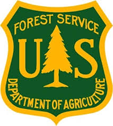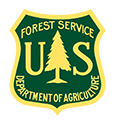U.S. Department of Agriculture

Agricultural Research Service (ARS)
Forest Service (USFS)
National Institute of Food and Agriculture (NIFA)
Natural Resource Conservation Service (NRCS)
Economic Research Service (ERS)

Agricultural Research Service (ARS)
The USDA Agricultural Research Service (ARS) Global Change National Program focuses on four aspects of global change: Carbon Cycle and Carbon Storage; Trace Gases; Ecosystem Impacts; and Changes in the Weather and the Water Cycle. There is much overlap between these components as all are influenced by each other. The goal of ARS’ carbon cycle and storage research is to provide the data and the process understanding necessary to describe the current and potential roles of agriculture in the global carbon cycle with sufficient accuracy to inform policy and aid producers and other land mangers in making decisions that are both economically and environmentally sound. Soil is the largest terrestrial carbon pool, and how agricultural soils (crop, pasture and range lands) managed greatly influences the amount of carbon that is stored in soil. In the conterminous U.S., agriculture is by far the largest land use. Thus, the management of agricultural lands has a large effect on the carbon cycle. Current estimates are that U.S. agricultural lands have the potential to sequester up to 220 Tg yr-1 of carbon, much of this due to past adverse land management that now can be rectified while keeping much of this land in production. Major ARS carbon cycle activities include GRACEnet and Agriflux. GRACEnet (Greenhouse gas Reduction through Agricultural Carbon Enhancement NETwork) is determining soil carbon status under current practices and developing practices to increase soil carbon sequestration, minimize greenhouse gas emissions, and document other production and environmental benefits in a variety of production systems at more than 25 locations across the U.S. The Agriflux network is determining CO2 exchange in range, pasture and crop land sites and examining how management influences this exchange. Other ARS research addresses carbon cycle dynamics and transformations in plants and soil, the development of improved analytical and measurement methods, the effects of CO2 enrichment and other environmental variables (temperature, water, ozone, etc.) using FACE (Free Air Carbon Enrichment) and other techniques on carbon cycle processes and the development of decision support systems. Most ARS research is conducted intramurally, although there is significant cooperation with university and other federal agency scientists. All ARS research is peer reviewed by the independent Office of Scientific Quality Review.

Forest Service (USFS)
The mission of USDA's Forest Service Research and Development (FS R&D) is “to develop and deliver knowledge and innovative technology to improve the health and use of forests and rangelands.” As a land management agency, the US Forest Service has a unique responsibility to address questions about climate change mitigation and adaptation involving the many issues that challenge forest and rangeland owners, managers, and users. FS R&D focuses its many strengths and capabilities to address questions about climate change impacts; the adaptation actions needed to increase resilience of forests and ranges to the impacts; the potential of forests to mitigate atmospheric greenhouse gas (GHG) concentration changes by storing additional carbon in living vegetation; and reducing fossil carbon use by increasing production of biofuels and substituting forest products for more GHG-intensive materials.
FS global change scientists are dispersed in many locations and work toward resolution of the many different issues and research needs of land owners and managers. There is an extensive infrastructure of research laboratories, long-term research studies, and continuous data from nation-wide forest surveys and experimental forests. More than a decade of focused global change research, a prior decade of air pollution research, and several decades of experience with integrated assessments provide a firm scientific foundation for continuing to address the challenges of global change and forest management. The FS global change research program is supported by strengths of its more traditional research in areas such as ecophysiology, landscape ecology, watershed hydrology, vegetation modeling, nutrient cycling, forest management and strong and productive partnerships with universities, federal and state agencies, NGOs and the forest industry here and abroad.
Overall FS R&D global change research priorities involve the three areas of adaptation (maintaining vegetation vitality to continue providing required ecosystem servides), mitigation (increasing carbon storage in soils, living plants and wood products, reducing fossil fuel emissions by increasing biofuel use), and policy support (national and international assessment writing, US and UNFCCC GHG reporting). Research priorities specifically focused on the carbon cycle are: (1) improving observations of forest carbon stocks and flows based on development and deployment of improved field measurement techniques and measurements integration, and maintaining a forest carbon-monitoring program component of the interagency research effort on the North American Carbon Program; (2) integrating observations with process-level studies to better understand, forecast, and manage the relationships between carbon in forest and rangeland systems and climate; (3) developing and deploying forest management systems and technologies that increase carbon sequestration, provide fossil fuel offsets, enhance productivity, and maintain environmental quality; (4) providing integrated prediction models of vegetation dynamics affecting ecosystem services, particularly including carbon storage and water supplies; and (5) improving technical information for forest greenhouse gas accounting rules and guidelines.
National Institute of Food and Agriculture
The mission of USDA National Institue of Food and Agriculture (NIFA) is to advance knowledge for agriculture, the environment, human health and well-being, and communities by supporting research, education, and extension programs in the Land-Grant University System and other partner organizations. The agency does not perform actual research, education, and extension but rather manages the funding (both competitive and formula based) for research, education, and extension at the national, state, and local levels, and provides program leadership in these areas. Through grants offered by NIFA, the USDA enables researchers throughout the United States to solve problems critical to our farmers, consumers, and communities. NIFA is USDA's major extramural research agency, funding both individuals and institutions. Funded research programs span problems and issues encompassed within five priority science areas: Global Food Security and Hunger, Sustainable Energy, Climate Change, Childhood Obesity, and Food Safety, each of which includes one or more research programs, each a compendium of related research, education, and extension activities. In cooperation with public institutions, private sector partners, and the Land-Grant University System, the agency provides national leadership to promote teaching excellence, enhance academic quality, and develop tomorrow’s scientific and profession workforce. Extension programs play an important role at all land-grant universities engaged in research and teaching. Extension means reaching out, along with teaching and research, to solve public needs with college or university resources through non-formal, non-credit programs, largely administered through thousands of county and regional extension offices, bringing land-grant expertise to local levels.
The NIFA climate change program focuses on land use, land cover, and managed ecosystems in terms of responses, feedbacks, and drivers of carbon and greenhouse gas fluxes, drawing upon issues in watersheds and water quality, air quality, soil processes and productivity, and agroecosystems. NIFA-funded projects generate knowledge to develop an agriculture system that maintains high productivity in the face of climate change. This will help producers and resource managers plan for and make decisions to adapt to changing environments and sustain economic vitality, including taking advantage of emerging economic opportunities offered by climate change mitigation technologies. The long term goal is to understand land change by integrating environmental and socioeconomic elements in predictive models that will ultimately lead to credible projections and scenarios at various space and time scales. The goal is to continuously improve decision-making for resource management while sustaining ecosystem goods and services.

Natural Resources Conservation Service (NRCS)
The Natural Resources Conservation Service (NRCS) provides leadership in conserving, maintaining, and improving our natural resources and the environment. Since 1935, NRCS (originally the Soil Conservation Service) has provided leadership in a partnership effort to help America's private landowners and managers conserve their soil, water, and other natural resources. NRCS provides financial assistance for many conservation activities. The Conservation Technical Assistance program provides voluntary conservation technical assistance to land-users, communities, units of state and local government, and other Federal agencies in planning and implementing conservation systems. Technical assistance is based on sound science customized to specific needs. NRCS reaches out to all segments of the agricultural community, including underserved and socially disadvantaged farmers and ranchers to ensure that its programs and services are accessible to everyone. NRCS manages natural resource conservation programs that provide environmental, societal, financial, and technical benefits. Science and technology activities provide technical expertise in such areas as animal husbandry and clean water, ecological sciences, engineering, resource economics, and social sciences. NRCS provides expertise in soil science and leadership for soil surveys and for the National Resources Inventory, which assesses natural resource conditions and trends in the United States. NRCS provides technical assistance to foreign governments and participates in international scientific and technical exchanges.
Economic Research Service (ERS)
The ERS mission is to inform and enhance public and private decision making on economic and policy issues related to agriculture, food, the environment, and rural development. With over 300 employees, The Economic Research Service is a primary source of economic information and research in the U.S. Department of Agriculture. ERS staff disseminates economic information and research results through an array of outlets, including:
Agency-published research reports, market analysis and outlook reports, economic briefs, and data products (all accessible on the Internet, with hard copies available for purchase)
An award-winning magazine, Amber Waves, covering the entire range of ERS work (available online)
The website, which provides access to all ERS products and which links users directly with ERS analysts
Oral briefings, written staff analyses, and congressionally mandated studies delivered directly to executive and legislative branch policymakers and program administrators
Articles in professional journals, and papers presented to academic colleagues at conferences and meetings




